
Digital lean manufacturing Industry 4.0 technologies transform lean processes to advance the enterprise
18 minute read
22 August 2020
While lean principles have long been used in manufacturing to drive efficiency and reduce waste, adding digital technologies to lean can take an enterprise to a whole new frontier.
A new era of lean
Lean principles have played a significant role in driving efficiency across organizations through their emphasis on cost reduction, focus on waste elimination, and reliance on letting customer demands drive processes. Although lean originated in manufacturing, its core tenets are found across many kinds of enterprises and applied in diverse ways. Lean can work in whatever domain it is applied because it provides a data-based approach to decision-making, emphasizing the tracking of root causes. Lean is often considered optimal for identifying hidden issues and emphasizes continuous improvement.1
Learn more
Visit the Deloitte Smart Factory Experience
Explore the Industry 4.0 collection
Learn about Deloitte's services
Go straight to smart. Get the Deloitte Insights app
The application of lean principles within a manufacturing context extends back several decades, even if the essential idea of reducing waste and driving efficiencies existed long before the term “lean” was coined. But lean as we understand it today has coalesced into a set of principles that has transformed manufacturing.
For their part, in more recent years, Industry 4.0 digital and physical technologies have made possible new accomplishments of speed, cohesion, flexibility, and automation that have forever altered what production looks like. Advances in robotics, materials, and artificial intelligence are all poised to be the future vanguards of manufacturing and beyond.2
As a result, digital technologies and lean principles are intersecting in what is commonly termed “digital lean”—which can be a powerful combination of timeless lean principles and constantly evolving digital technologies to decrease waste and variability in processes.
The emergence of this new era begs new questions: How do Industry 4.0 digital and physical technologies enhance lean manufacturing? What principles of lean manufacturing remain relevant today, will be relevant in the future, and apply to companies embracing digital lean? What are some of the benefits of digital lean—and common pitfalls that practitioners should avoid? How should a practitioner even get started? This report aims to answer these and other questions in exploring how Industry 4.0 enables companies to become digital lean.
What is Industry 4.0?
To learn more about how Industry 4.0 signifies the promise of a new industrial revolution—one that marries advanced production and operations techniques with smart digital technologies to create a digital enterprise—visit the Deloitte Insights Industry 4.0 collection.
What is lean?
With roots in Japanese automobile manufacturing that date back to the 1930s, lean represents a set of principles to minimize waste, enabling more productive time. And, despite its manufacturing pedigree, lean can work in any process-driven environment regardless of industry. The end objective of lean is to identify—and eliminate or change—any part of a process that does not add value. In so doing, lean enables quicker responses to changing customer demands and results in faster and more robust production, increased quality, and lower costs.
Figure 1 depicts the seven types of waste that lean processes commonly aim to eliminate.3
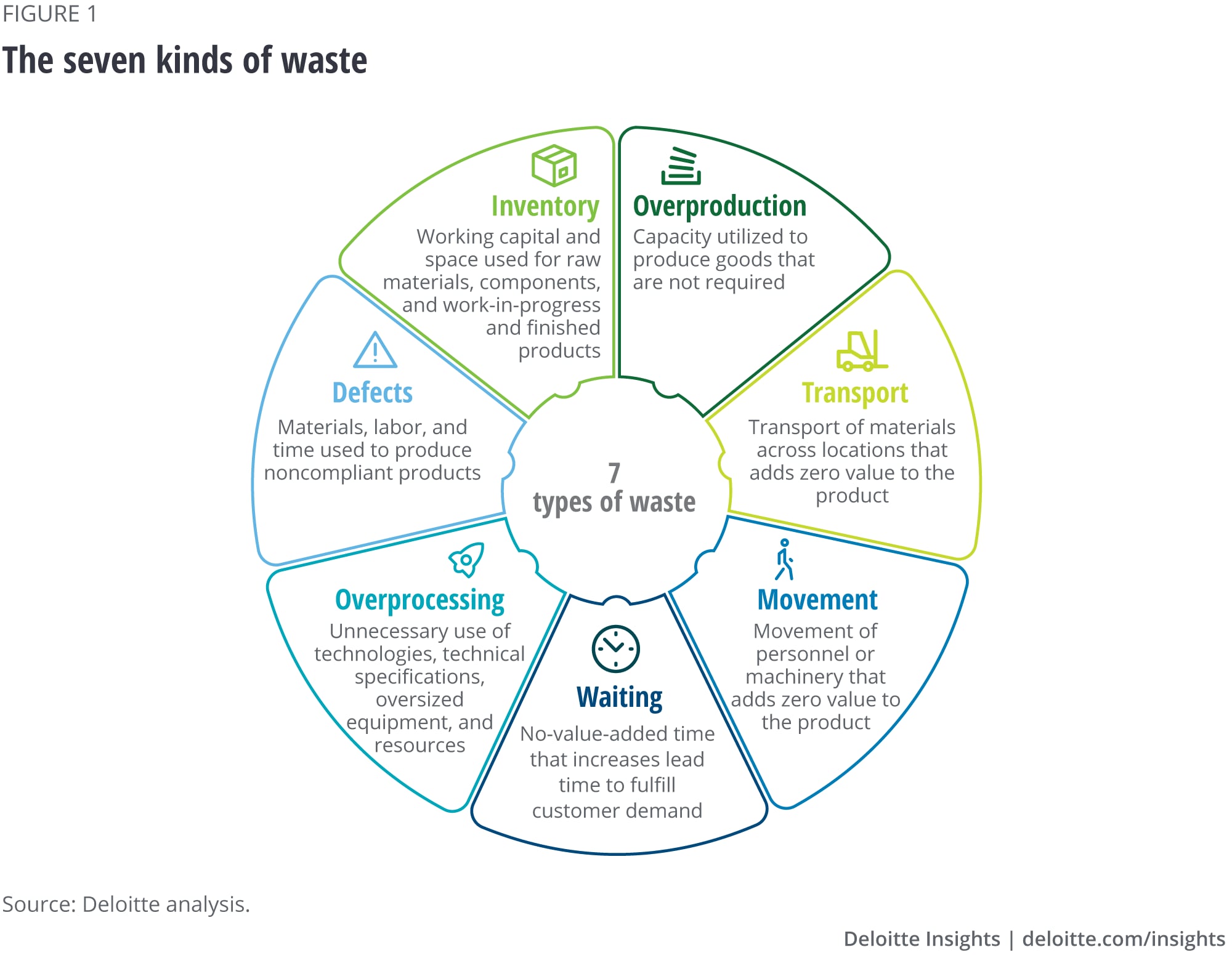
Digital lean as a game changer for continuous improvement
Digital lean is not a new set of lean principles, per se, but it enhances lean principles to make their application more powerful. While systems of record, such as enterprise resource planning, often report on operations as they impact company and plant financials, many digital lean systems of innovation produce detailed information on all aspects of a process. Digital lean uses Industry 4.0 and other digital tools to provide more accurate, precise, and timely information about operations. It not only helps realize lean principles but also increases the impact of core lean tools, such as kanban, which we will discuss later. Moreover, the increased availability of high-frequency data from Industry 4.0 technologies, coupled with growing processing power, has led to new analytics and insights that were virtually impossible several years ago.
The reduction of waste: Traditional vs. digital lean
Digital lean can complement the gains from traditional lean in reducing the waste types during production depicted in figure 1. Digital lean accelerates waste identification and mitigation faster than traditional lean methods by giving targeted, detailed information directly to those who can reduce waste. However, digital lean also provides an opportunity to target hidden components of waste, such as information asymmetry and latency, that often go unnoticed and that cumulatively add up to higher support costs and reduced efficiency and output, resulting in tangible bottom-line impact.
Figure 2 illustrates how both traditional lean and digital lean processes typically mitigate the seven waste types.
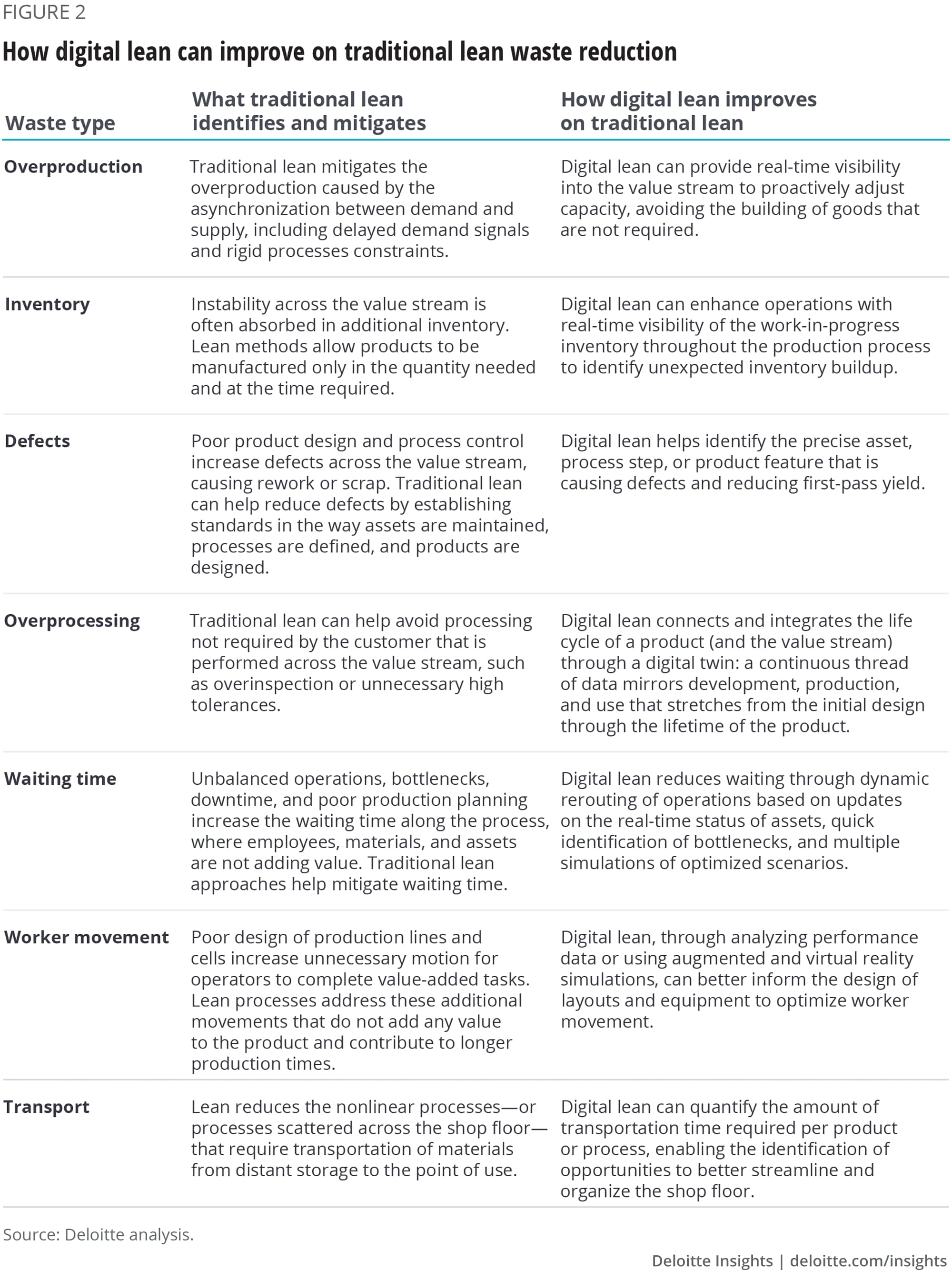
Key enablers of digital lean
Digital lean generally requires three key enablers at a plant, and every plant will have different immediate needs across the three areas.4
Getting the data: IT and OT collaboration
Prior to Industry 4.0, information technology (IT) and operational technology (OT) were mostly two distinct areas with little to no overlap. To unlock its full potential, digital lean requires an integration of IT and OT (control systems, industrial networks, etc.), which brings plant and operations data to plant and business users.
Standardized processes: Process and data management
Plant processes generate data that serves as input for digital lean. But if processes are not carried out with standardization and discipline, accurate and continuous data could not be forthcoming. As a result, the impact of a digital lean initiative would be muted. Key in this regard is the role of plant leadership in defining and enforcing processes to ultimately provide more accurate data.
Bringing the process to life: Data-enabled technology platforms
As important as IT and OT collaboration and disciplined process and data management are, relevant technological platforms should be leveraged to truly harness the benefits of digital lean. When choosing a technology platform, such as a digital twin, organizations should be sure to consider factors such as platform flexibility, integration with other systems, and data administration.
Digital lean in manufacturing plants: Lean tools enhanced
As discussed, the core principles of lean can help us identify the types of waste to eliminate. However, as these principles are thematic, it is important to drill down a level further to understand the tactical drivers of traditional and digital lean that affect the more granular tasks and activities in a manufacturer’s lean program.
Take, for example, the case of a medical equipment manufacturer. In that environment, the credo may be to craft a higher-quality product, yet there are so many ways to do so by innovating or improving the people, processes, or technologies on the shop floor. With high morale and robust training, a worker’s productivity and attention to detail may increase. However, you could also further that vision by utilizing new digital lean capabilities, such as a smart screwdriver that captures torque values and runs analytics to determine whether a fastener is correctly installed or whether an input material is defective. As companies transition from traditional to digital lean, it is important that they understand the digital extension of each lean tool, and whether that extension will add value to the traditional approach.
Each traditional lean tool serves a unique function on the manufacturing floor. For example, to create a consistent production flow, a manufacturer may turn to heijunka, a scheduling methodology that “levels” production to balance and optimize workloads across the plant floor. As another example, judicious application of kanban signals when the inbound flow of materials or products is needed just in time. A different lean tool, total productive maintenance, may be the tool of choice to proactively address equipment performance, eliminate breakdowns, or ensure that optimized production flows are not disrupted.5
The application of the key enablers mentioned above, when paired with the traditional lean methods and tools, form the heart of the digital lean transformation—in essence making lean tools digital. Figure 3 provides more detail on how just a few lean tools can be extended to digital lean.
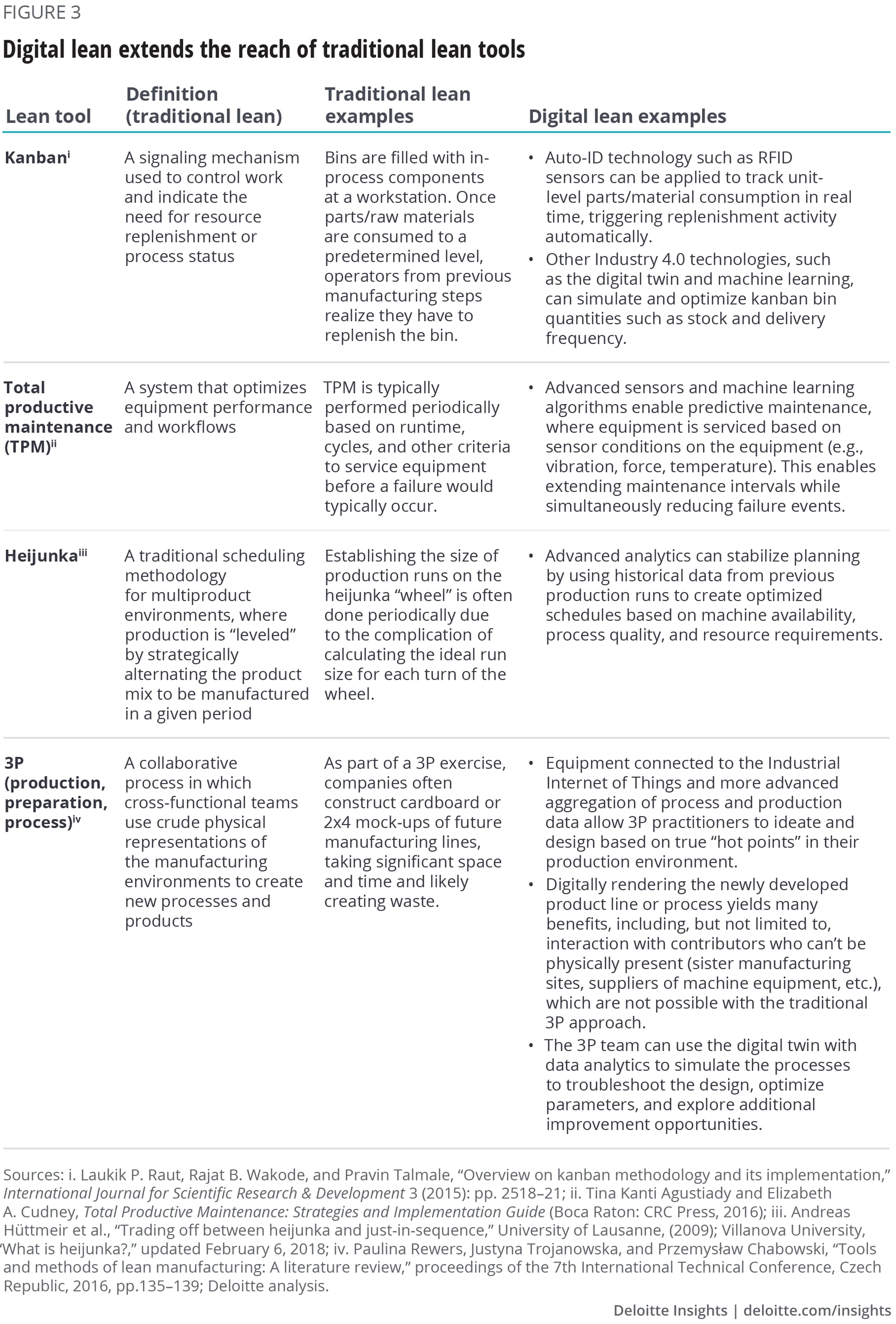
Global plastics leader goes digital lean
A global leader in plastics had long practiced traditional lean principles in its manufacturing processes, but the company still lacked data visibility and process standardization. As a result, the company experienced eroding margins from lost manufacturing productivity and was unable to meet its aggressive sustainability and innovation goals.
To achieve productivity, sustainability, and innovation targets, the company embarked on a digital culture transformation and a new set of digital lean capabilities. Specifically, the company built a digital manufacturing core by capturing high-frequency machine data in an operational historian, essentially a time-series database application. It then leveraged connected asset data and, applying lean and digital techniques, improved performance further. The company also sought buy-in from key stakeholders, particularly those who influence user adoption on the production floor. The final step was to introduce a chief digital officer and new cross-business unit teams to own the digital transformation.
The transformation from lean to digital lean is expected to generate improvement in earnings before interest, taxes, depreciation, and amortization of US$20 million annually, reduce costs by 15% per line per year, and improve overall equipment effectiveness (OEE) by 11% annually. Perhaps more importantly, the transformation instilled a digital mindset in the organizational culture.6
Benefits of digital lean
When digital lean is implemented successfully, organizations can expect to reduce costs and improve quality, in turn leading to better productivity and a stronger return on investment (ROI) when compared with individual digital or traditional lean improvement projects implemented in isolation.
A new productivity frontier
A manufacturer that relentlessly focuses on eliminating waste and continuously improving the manufacturing process armed with only traditional tools, such as kaizen, can make great progress initially, but its productivity increases typically shrink over time.7 With digital lean, the manufacturer can build on its lean foundation and leverage new technologies, such as machine learning and predictive maintenance, to solve previously unsolvable business problems and unlock previously unreachable productivity frontiers. A general progression of optimization is shown in figure 4.
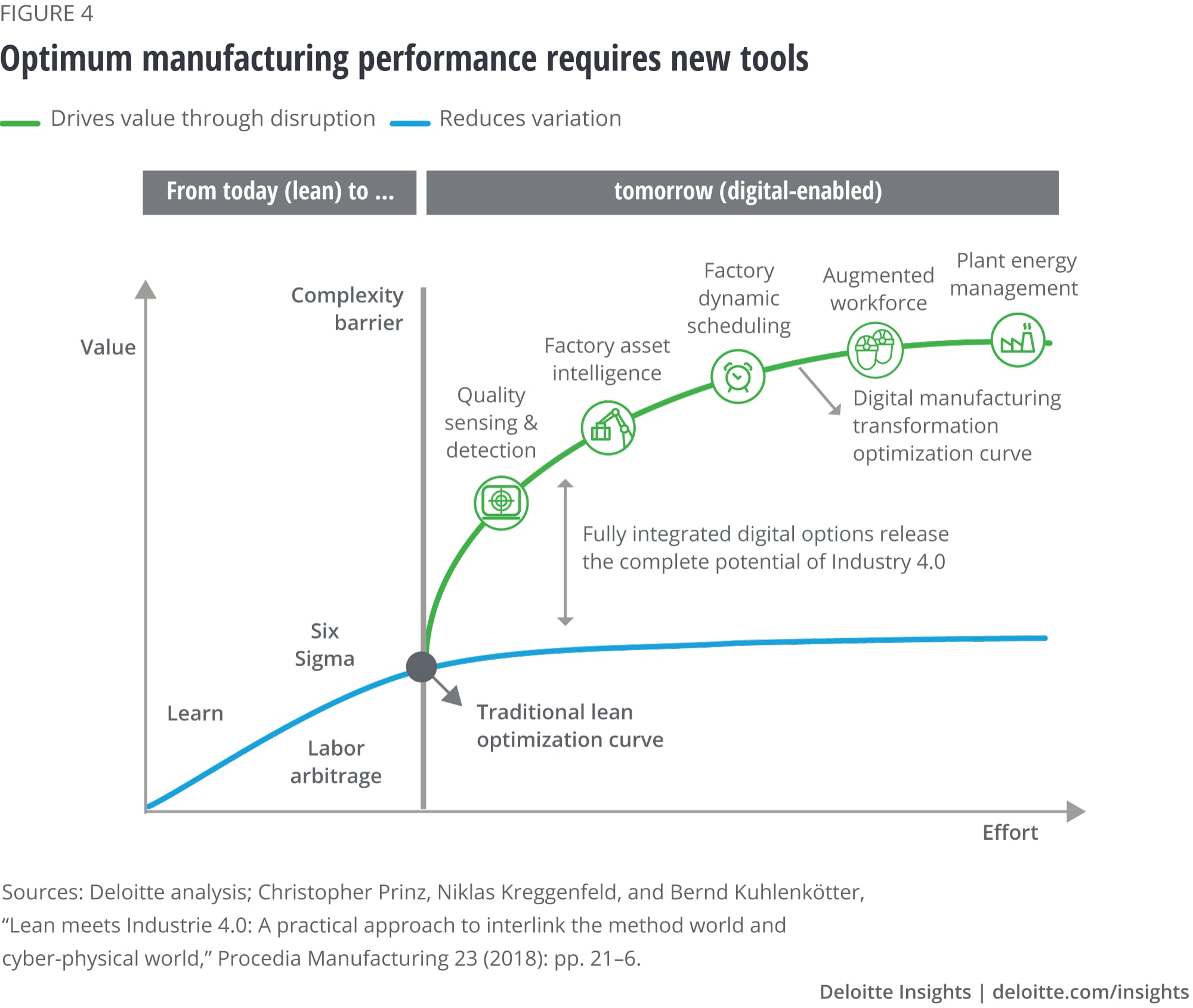
Intense management practices and technology deployment drive ROI and enhance performance measures
There is clear business value in traditional lean improvement and technology or IT implementation projects. However, when manufacturers implement digital solutions combined with intense management processes (including lean, Six Sigma, etc.), many manufacturers can achieve higher ROI when compared with lower-intensity deployments or digital projects implemented in isolation. Digital lean already unites digital with management practices to solve business problems. An organization that uses digital lean with intensity on applicable, high-value business problems can potentially expect to see the greatest returns.8
Moreover, digital lean transformations and improvement projects target long-established performance measures such as improving OEE, reducing cost, and improving safety and sustainability. When approaching the plateau of the traditional lean optimization curve, manufacturers have seen considerable incremental value across all traditional measures by focusing on digital lean improvements, as figure 5 suggests.
The ranges in figure 5 are percentages of available opportunity and are driven by several factors that should be evaluated during business case development. To achieve the greatest ROI, manufacturers should focus digital lean initiatives and programs in the largest areas of opportunity. These generally include unlocking the capacity of constrained assets, improving strategic asset efficiency, decreasing comparatively high total costs of poor quality, decreasing labor spend, and decreasing or eliminating unnecessary raw material cost.
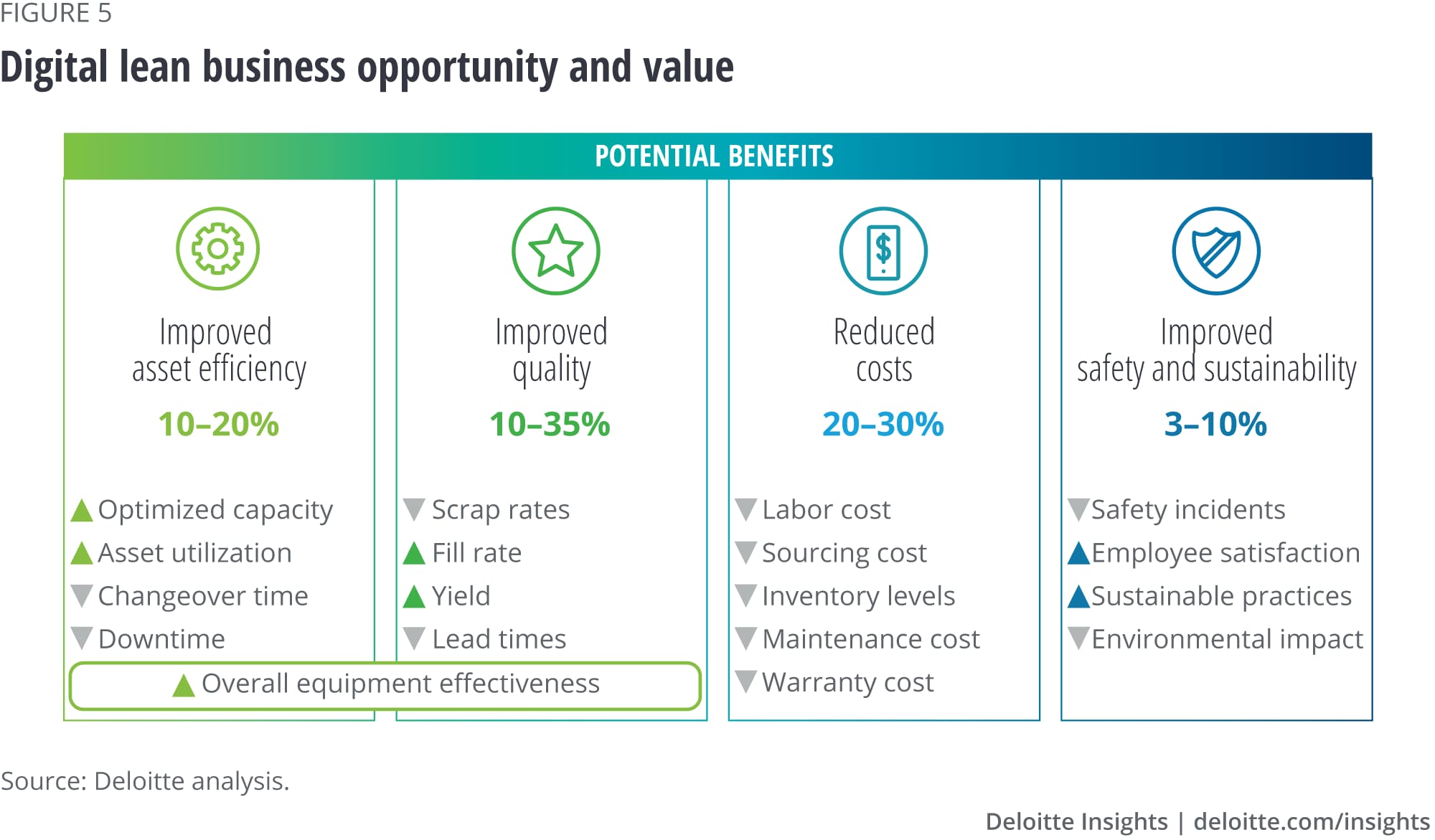
Avoiding the challenges of digital lean
Transforming to digital lean will come with challenges. However, these can be overcome with an understanding of its common pitfalls and proper planning.
Focus on value first, technology second
When implementing new technologies, manufacturers often get caught up in a digital program that does not focus on solving the most urgent business problems, but rather explores a technology. Poorly targeted technology projects and process improvements can lead to program fatigue (“pilot purgatory” or “random acts of digital”) and even negative returns for a business. This can be avoided by conducting a detailed assessment, ensuring initiatives align to where there is opportunity to capture value, and developing rigorous business cases that can be tracked during implementation. Each discrete initiative should drive improvement of agreed-upon operational metrics (or key performance indicators) that can be linked to hard financial benefits. As initiatives are implemented, metrics should be tracked and reported to ensure program value is captured.
Choose the right starting point
Before launching a digital lean effort, it is important to identify the right starting point. Often, companies choose a well-understood plant or line on which to focus. However, within that plant or line, they will need to evaluate the people, process, and technology readiness to choose the exact starting point.
Change management
Digital lean transformations require people to learn different ways of working, behaviors, and decision-making. Ask yourself questions such as, does the plant leadership make changes stick, or is this a struggle? Are the operators resistant to change how they’ve been working for years, possibly decades? Will the operators and leaders believe the data or their experience more? Is there a change management program in place to guide the transformation, or will it need to be developed? The answers to these questions about a target plant or line should help determine the place to start digital lean efforts.
Consistency in process
Moreover, lean principles focus on reducing waste and, as a result, reduce process variation. Digital lean accomplishes this objective more efficiently. When choosing a starting point, it is beneficial to start with a problem to solve where the production process is consistent and is well known by the plant. Questions to consider include, is the relevant standard available and up to date? How relevant is the actual production process? Is production performance tracked rigorously? Is there a continuous improvement group or process in place? Are root causes of defects and maintenance issues clearly understood?
Technology enablement
Often, digital lean initiatives require a solid foundation of technology. For example, does the facility have satisfactory network connectivity? Is critical process data currently being extracted from machines and other process stages? If so, is the data in a format that is digestible? Enabling the technology to capture data is one of the foundational steps to becoming digitally lean and realizing the previously mentioned benefits.
Don’t just assume stakeholder buy-in—secure it
Few people like change. Overcoming the “this is how we’ve always done it” mindset is challenging. Engaging the workforce early and often can be critical for any digital lean initiative, including expressing the value of the tool to every stakeholder. The best way to do this could be to develop user personas for each stakeholder that illustrate how the new tool can add value to their daily job. Involving the primary users of the tool from the start can significantly increase adoption and utilization of the tool. In addition, this would also socialize the impact of the tool to further increase adoption. These actions represent one part of a robust change management plan, which is often critical to ensuring networkwide adoption of the new tools.
While buy-in from formal leadership is important, the buy-in from the people who hold informal influence is also important. While in a manufacturing environment, spend time observing the shop floor. Ask who the influencers are—the people who provide answers to knotty questions and who always seem willing to lend a helping hand. While these influencers may not hold formal authority, they have plenty of informal authority and credibility, which may actually be even more powerful. Gaining the buy-in of these influential individuals who garner power and respect among colleagues will likely validate the tool or initiative and can create a higher likelihood of success.
Avoid near-term focus
In dynamic business environments, spending time, energy, and money to invest in strategic projects that may not deliver immediate value can be challenging. This also applies to talent acquisition, as a plant may be more interested in hiring a skilled technician who can deliver right away in the current environment rather than an individual who is interested in learning and adopting new digital ways of working. The business case for a complete digital lean transformation is generally focused around step-change improvements, not incremental improvements. This type of transformation potentially yields high benefits, as we discussed earlier, but it is most importantly a journey that changes the ways of working, employees’ behaviors, and how decisions are made in a plant, which does not happen overnight.
Concluding thoughts: A way to get started
Digital lean is typically effective and robust. It can reduce the effort to understand operations and generate more accurate, precise, and timely information. It is more than a set of Industry 4.0 tools—encompassing re-evaluating current processes using a digital mindset, changing behaviors, and shifting decision-making away from experience-based to data-based far more efficiently than lean processes alone could ever do. Moreover, targeted, strategic digital lean efforts do not necessarily require significant upfront investment to realize benefits in weeks.
But how should one go about setting forth down the digital lean path? One plausible approach may begin with thinking big, then starting small, and, finally, scaling fast.
Thinking big establishes the vision and the associated capabilities to develop. Many companies use a digital foundry for this purpose. A digital foundry sets a mission and strategy, manages the portfolio of digital lean investments and activities to develop capabilities, and scales the digital lean solutions across the enterprise.
Then, start small with a pilot where the solution can capture measurable new value and where the people, process, and technology are ready for change. Consider the following specific characteristics and attributes when selecting a target to pilot for digital lean capabilities:
- Compelling operational issue—Look for a production line or work cell where there is a critical issue to be solved involving an asset that is used widely within the plant or across the manufacturing plant network. An already extremely high-performing production line may enjoy benefits from digital lean, but such benefits will likely be less than ideal for an initial pilot that is bearing the cost of development of capabilities. Good places to start often include lines or assets with bottlenecks (select a process, value stream, or sub-value stream with a clear bottleneck resulting in low OEE, such as high downtime); or with quality defects (situations where scrap and defective products are created at a specific step and not immediately detected are ideal).
- People, process, and technology readiness—Choose a target where the personnel are familiar with and enjoy experimentation, where process execution discipline is strong, and where production lines already have a level of connectivity and integration to save time and expense.
- Measurable impact—Determine in the pilot planning how the impact will be measured. Not all scaled digital lean efforts generate enough value to meet the business case.
Scaling fast can generate the business case value. Most digital lean efforts meet the business case while scaling the solution, not during the initial pilot. Each scaled pilot helps realize value and build the capabilities that are defined while thinking big. Determine the order of assets, lines, or plants to scale, and develop and execute plans accordingly during the pilot. Scaling usually occurs in one plant, then in other similar plants, then to a broader network. When the solution’s measured value does not meet expectations during scaling, identify the reasons why (e.g., a bottleneck in the same value stream limited the solution’s value).
Digital lean provides new ways to eliminate waste and make people, processes, and technology more productive. Coupled with a deliberate, value-driven approach, digital lean can put companies on a new productivity frontier that can lead to a factory with higher efficiency and lower operating costs than ever would be possible with traditional lean manufacturing.
© 2021. See Terms of Use for more information.
Explore the Industry 4.0 collection
-
Swim, not just float Article4 years ago
-
Navigating disruption Article5 years ago
-
Unlocking end-to-end digital fulfillment Article5 years ago
-
Digital platform as a growth lever Article4 years ago
-
Implementing the smart factory Article5 years ago














